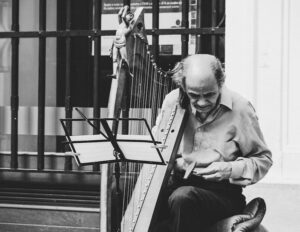Mastering Melody: Tips for Playing the Harp

harp
The harp is a stringed musical instrument with individual strings that run at an angle to the soundboard and are plucked with the fingers. Harps have been known in Asia, Africa, and Europe since antiquity, dating back to at least 3500 BC. They have also appeared in artworks, folktales, and songs from various countries and periods.
Harps vary in size, construction, and string count around the world. Smaller, portable Celtic or folk harps have a distinct shape and sound that sets them apart from their larger, grander cousin, the concert pedal harp. The orchestral harp, often known as the pedal harp, is more commonly heard in symphony orchestras and other big ensemble groupings. It’s famous for its intricate pedal mechanism, which allows the player to play in several keys without retuning the strings.
Lap harps and lyres are even smaller and more portable, yet they produce the same characteristic, resonant sound as harps.
Playing the harp necessitates a distinct set of abilities. A harpist plucks the strings with their fingertips, and the unfretted strings enable a unique glissando effect, in which a series of notes is played in a single continuous sweep.
The harp, with its elegant appearance and calming music, is frequently linked with peace and romance. Its adaptability allows it to fit into a variety of musical styles, from classical to folk to jazz and pop. The harp continues to wow audiences today with its ageless beauty and ethereal melodies.

Tips for Playing the Harp
Playing the harp can be a rewarding experience, but like any instrument, it requires practice, patience, and proper technique. Here are some tips for playing the harp:
Proper Posture: Make sure you’re sitting comfortably and correctly. Your back should be straight, and the harp should rest against your right shoulder. The harp’s neck should be positioned at about shoulder height.
Hand Position: The position of your hands is crucial. Your hands should be relaxed, and your fingers should curve naturally, as if holding a small ball.
Plucking the Strings: When plucking the strings, move your fingers into your palm, not sideways or up. This motion ensures a full, resonant tone.
Using Both Hands: Harp playing often involves using both hands in a coordinated way. Usually, the right hand plays the melody, and the left hand plays the accompaniment or bass. Practice hands separately at first to build confidence.
Reading Harp Music: Learn to read harp music, which can include standard music notation, as well as specific symbols for techniques like muffling or harmonics.
Practicing Scales and Arpeggios: These are fundamental to mastering the harp, as they improve finger agility, strength, and control.
Regular Practice: Like any instrument, regular and consistent practice is the key to improvement. Start slow and gradually increase the complexity of the pieces you’re practicing.
Care for Your Instrument: Regular maintenance, such as tuning and cleaning, will keep your harp sounding its best.
Patience: Playing the harp is a journey. It can take time to coordinate both hands and read music simultaneously. Be patient with yourself.
Harp Lessons: Consider taking lessons from a professional harp teacher. They can provide you with personalized feedback and help guide your progress.







